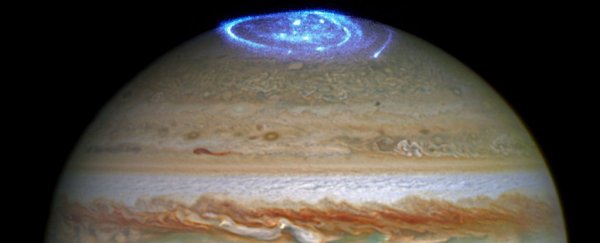The more we find out about Jupiter, the more we discover it's really nothing like what we expected, and now the Jovian giant is perplexing scientists with what could be its greatest mystery yet.
Jupiter's spellbinding auroras are in fact the most powerful auroras in the whole Solar System, and now new measurements taken by NASA's Juno spacecraft have revealed these cosmic light shows are generated by a completely unexpected power source.
"At Jupiter, the brightest auroras are caused by some kind of turbulent acceleration process that we do not understand very well," explains lead researcher Barry Mauk from Johns Hopkins University.
The Jupiter Energetic Particle Detector Instrument (JEDI) recorded energy signatures above the gas giant's north pole as Juno whizzed by at more than 160,000 km/hr (100,000 mph).
At that speed, the device had only seconds to make its measurements, but doing so gave us our first chance to directly observe the processes behind Jupiter's auroral emissions – and it turns out they're very different to the ones on Earth.
 A reconstruction of Juno's polar flyby. Credit: Bertrand Bonfond
A reconstruction of Juno's polar flyby. Credit: Bertrand Bonfond
On our home planet, the most intense auroral glows are created by wells of electric potential, which accelerate electrons towards the surface along lines in Earth's magnetic field.
When these charged particles collide with gases in Earth's upper atmosphere, the gas molecules end up releasing photons, which produce brilliant, swirling light shows in the sky above polar regions.
"[T]hese are the beautiful twisting snake-like undulations that people marvel at when they go see the aurora in northern regions," Mauk told Leah Crane at New Scientist.
Juno's flyby revealed that electrons in the Jovian atmosphere are accelerated towards Jupiter at energies up to 400,000 electron volts – which is up to 30 times higher than the largest auroral potentials observed on Earth.
In other words, the light shows above Jupiter's poles should be beyond stupendous – and they are – but strangely, not because of the way the phenomenon plays out on Earth.
On Jupiter, lights in the sky, like most things, are very different.
"Basically, the aurora is a factor of 10 brighter than it should be based on Earth-like physics," Mauk explained to Wired.
"After orbit seven we saw what I would consider to be the smoking gun."
That smoking gun amounted to hints in the data that as the electric potentials in the magnetic field build towards an energetic crescendo, they become unstable, breaking into waves of random turbulence.
These waves could end up propelling electrons themselves – much like surfers being carried ahead of a wave of water – and Mauk's team suggest this is what's responsible for producing Jupiter's brilliant displays.
For now, it's just a working hypothesis, as the team don't fully understand what's going on here.
But this wave-based motion is the best explanation we have, in a case that highlights just how inaccurate our scientific assumptions can sometimes be, especially when trying to predict processes taking place far beyond our own planet.
When we model physical sciences across space, we can't help but base what we know on the limits of what we can observe from here on Earth, at least to some degree.
But when we can reach out closer to what's happening out there in space, it can throw us some truly amazing surprises from time to time.
"That to me is very exciting because it means we've got a lot more work to do to figure out what is exactly going on," astrophysicist Jonathan Nichols from the University of Leicester in the UK, who wasn't involved with the study, told The Verge.
"Jupiter isn't going to give up its secrets as lightly, it seems."
The findings are reported in Nature.
